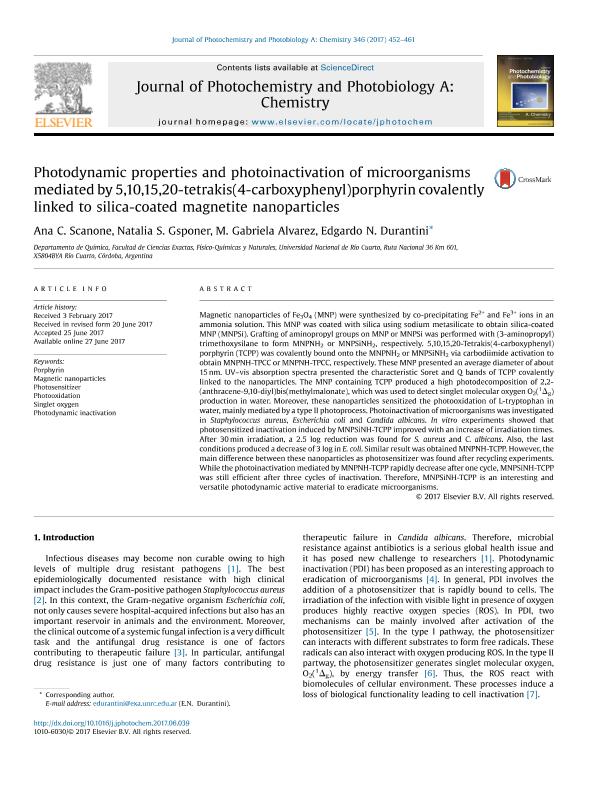Artículo
Photodynamic properties and photoinactivation of microorganisms mediated by 5,10,15,20-tetrakis(4-carboxyphenyl)porphyrin covalently linked to silica-coated magnetite nanoparticles
Fecha de publicación:
09/2017
Editorial:
Elsevier Science Sa
Revista:
Journal of Photochemistry and Photobiology A: Chemistry
ISSN:
1010-6030
Idioma:
Inglés
Tipo de recurso:
Artículo publicado
Clasificación temática:
Resumen
Magnetic nanoparticles of Fe3O4 (MNP) were synthesized by co-precipitating Fe2+ and Fe3+ ions in an ammonia solution. This MNP was coated with silica using sodium metasilicate to obtain silica-coated MNP (MNPSi). Grafting of aminopropyl groups on MNP or MNPSi was performed with (3-aminopropyl)trimethoxysilane to form MNPNH2 or MNPSiNH2, respectively. 5,10,15,20-Tetrakis(4-carboxyphenyl)porphyrin (TCPP) was covalently bound onto the MNPNH2 or MNPSiNH2 via carbodiimide activation to obtain MNPNH-TPCC or MNPNH-TPCC, respectively. These MNP presented an average diameter of about 15 nm. UV–vis absorption spectra presented the characteristic Soret and Q bands of TCPP covalently linked to the nanoparticles. The MNP containing TCPP produced a high photodecomposition of 2,2-(anthracene-9,10-diyl)bis(methylmalonate), which was used to detect singlet molecular oxygen O2(1Δg) production in water. Moreover, these nanoparticles sensitized the photooxidation of L-tryptophan in water, mainly mediated by a type II photoprocess. Photoinactivation of microorganisms was investigated in Staphylococcus aureus, Escherichia coli and Candida albicans. In vitro experiments showed that photosensitized inactivation induced by MNPSiNH-TCPP improved with an increase of irradiation times. After 30 min irradiation, a 2.5 log reduction was found for S. aureus and C. albicans. Also, the last conditions produced a decrease of 3 log in E. coli. Similar result was obtained MNPNH-TCPP. However, the main difference between these nanoparticles as photosensitizer was found after recycling experiments. While the photoinactivation mediated by MNPNH-TCPP rapidly decrease after one cycle, MNPSiNH-TCPP was still efficient after three cycles of inactivation. Therefore, MNPSiNH-TCPP is an interesting and versatile photodynamic active material to eradicate microorganisms.
Archivos asociados
Licencia
Identificadores
Colecciones
Articulos(CCT - CORDOBA)
Articulos de CTRO.CIENTIFICO TECNOL.CONICET - CORDOBA
Articulos de CTRO.CIENTIFICO TECNOL.CONICET - CORDOBA
Citación
Scanone, Ana Coral; Gsponer, Natalia Soledad; Alvarez, María Gabriela; Durantini, Edgardo Néstor; Photodynamic properties and photoinactivation of microorganisms mediated by 5,10,15,20-tetrakis(4-carboxyphenyl)porphyrin covalently linked to silica-coated magnetite nanoparticles; Elsevier Science Sa; Journal of Photochemistry and Photobiology A: Chemistry; 346; 9-2017; 452-461
Compartir
Altmétricas




